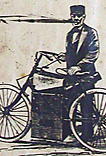 Sylvester Roper built the first self-propelled two-wheeled machine in America. Roper’s steam-powered bicycle made its first public appearance in 1869 in his hometown of Roxbury, Massachusetts. The bike was a hit with the public and Roper toured the fairs and circuses of New England for the rest of his life, demonstrating his inventions. Roper died in a crash while riding exhibition laps at an indoor bicycle velodrome aboard one of his steam-powered bikes.
Sylvester Roper built the first self-propelled two-wheeled machine in America. Roper’s steam-powered bicycle made its first public appearance in 1869 in his hometown of Roxbury, Massachusetts. The bike was a hit with the public and Roper toured the fairs and circuses of New England for the rest of his life, demonstrating his inventions. Roper died in a crash while riding exhibition laps at an indoor bicycle velodrome aboard one of his steam-powered bikes.
Roper was born on November 24, 1823, in Francestown, New Hampshire. His father was a cabinetmaker and young Sylvester followed in his father’s footsteps and became a craftsman. As a boy, all things mechanical fascinated Roper and as a teenager he became an avid inventor. By age 12, he’d constructed a small stationary engine and two years later a locomotive engine. Roper left home early to pursue a living as a machinist. He worked in several towns before settling in Boston in 1854.
Roper proved to be a tireless inventor. He designed and built a wide range of products including sewing machines, guns, machine tools, furnaces, automatic fire escapes and eventually steam-powered carriages and bicycles. His son, Charles, joined him in business and ran a company that made screw-making machines.
In 1869, just four years after the American Civil War, Roper attached a twin-cylinder steam engine to a hickory-framed velocipede. Roper's bike, which rolled on iron-shod wooden wheels, had one cylinder on each side of the frame connected by rods to driving cranks on the rear wheel axle. A firebox and boiler were spring mounted and suspended between the wheels, and a short chimney projected up from behind the saddle. A charcoal fire was built in the grate beneath the boiler. The fire’s heat boiled the water in the boiler and produced steam to power the engine. Water was supplied from a reservoir in the seat.
A cable attached to the handlebars operated the throttle valve. Tightening the cable activated the valve and rotating in the opposite direction applied the spoon-type brake on the front wheel. Footrests were attached to the front axle ends.
While his steam-powered bike was popular at exhibitions, Roper's neighbors were less thrilled Roper’s steamer was described in local news reports as loud and emitting an acrid odor. When riding into town, Roper would spook horses and often annoy townspeople. Roper was once arrested on one of his rides, but quickly released when it was determined that he had broken no laws.
In 1895, with backing from the Pope Manufacturing Company, Roper built an improved version of his steamer bike. Pope foresaw the possibility of adding new business to its bicycle empire. By the end of the century, gas-powered motors were already beginning to prove viable, but Roper was by now in his 70s and had more than 30 years of experience with steam power, so he continued in vain with this project.
His latter steam-powered bicycle had a one-gallon water reservoir, which was good for a journey of eight miles. On test rides into town, Roper would remove the burning coals on arrival and place them in a small covered bucket. When he was ready to leave, he would re-stoke the fire, get up steam, and return home.
By 1896, Roper felt he had his new machine perfected. On June 1 of that year, he took the steamer to the Charles River bicycle racetrack in Boston to test its viability as a pace-making machine for bicycle races.
Roper made a few exhibition laps around the track and several bicycle racers attempted to keep up with him but were unable to do so. Initially, Roper covered a mile in two minutes and 12 seconds. He was so elated, that he decided to try for an even better time. He scorched around the 1/3-mile wooden track, but he went into a big wobble on the back straight and was thrown off the track and into the sand surrounding it. When the spectators rushed up, it was apparent that Roper was dead. It was later determined that he had died of heart failure, not as a result of the accident itself.
While Roper’s two-wheeled inventions never found commercial success, his innovations provided inspiration and direction for inventors in the gas-powered motorbike era at the turn of the century.
Both of Roper’s steam-powered bicycles survived and were put on display at museums. The Smithsonian owns his original steam bike.